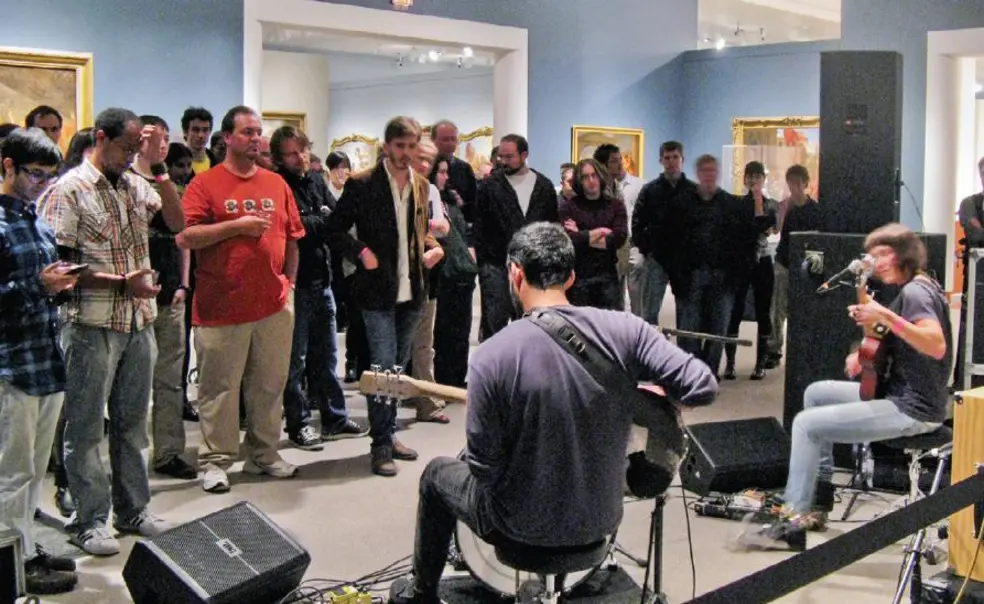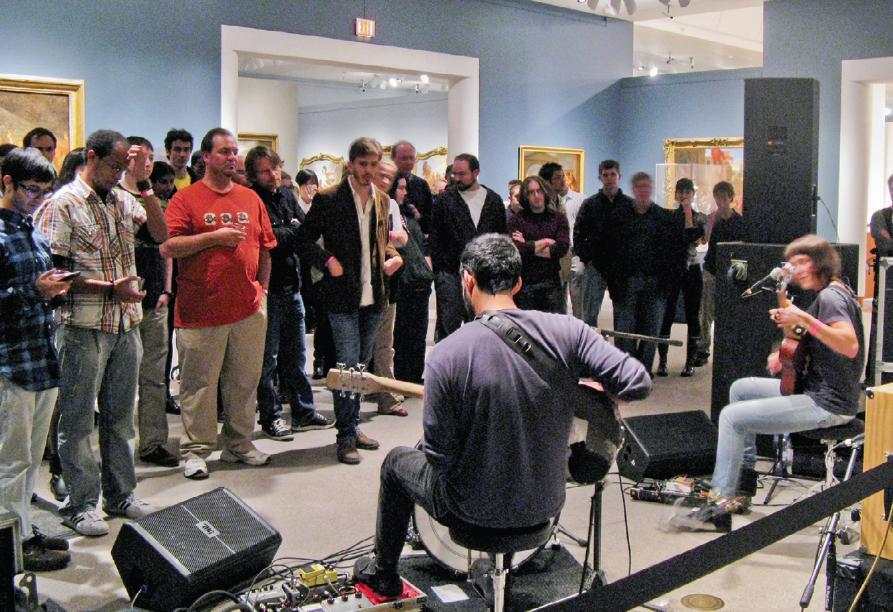A Place for All: The Princeton University Art Museum
Under the inspired leadership of James Steward, who joined us in 2009, the Princeton University Art Museum has extended the warmest of welcomes to visitors, especially students, and visiting exhibitions as it explores new ways of fulfilling its role as a center for object-based study and instruction and an important part of our renewed commitment to the creative and performing arts. I have invited James to give you an overview of this exciting time in the life of one of Princeton’s greatest treasures. — S.M.T.
When the Princeton University Art Museum was founded in 1882, the University and the world were rather different from what they are today. The field of academic art history was almost new to higher education—a progressive import from Germany as a new field of scholarly inquiry. The public art museum was a still young construct, the fruit of the European enlightenment and one focused on “public improvement,” but not yet particularly interested in true populism. Tourism of the kind that might make the world’s cultural treasures available for discovery in the first person was limited to a very privileged few. And many of the objects regularly collected by museums today would have been unknown or of little interest: Japanese art was a radical new discovery in the West; photography was barely 40 years old; and African art as a subject of aesthetic focus was unimaginable.
Although the University had been acquiring art since the 18th century (Charles Willson Peale’s George Washington at the Battle of Princeton was commissioned by the trustees of the College of New Jersey in 1784), over a hundred years passed before a museum was thought necessary, both to assure the “laboratory” use of art in the University’s teaching and to care for and manage the University’s growing collections. Another 129 years later, we are probably further removed from the Victorian ideals of McCosh’s Princeton than the Victorians were from those who helped the College of New Jersey survive the revolutionary battle fought on its doorstep. From their humble beginnings as a collection largely confined to pottery and porcelain, the museum’s holdings have grown to encompass more than 72,000 works of art spanning the globe and 5,000 years of history, including collections of pre-Columbian art, Chinese painting, and photography that are among the finest in the world.
Much as the museum builds on the past, we are by no means defined or constrained by it. We remain committed to being a vital teaching laboratory for the Department of Art and Archaeology, with which we were co-founded (and with which we continue to share a roof). But our ambition today is to serve as an essential resource in the experience of every Princeton student, whether on the level of formal classroom engagement, on what I term the cocurricular level (including internships and less structured learning opportunities), or on the social level. In doing so, we seek not only to position the museum as a multifaceted center for the arts but as a key tool in advancing President Tilghman’s goal of making the arts available to every Princeton student as maker, observer, critic, and patron.
To that end, the museum has in the past two years launched a set of new initiatives to reach both further and deeper into the student population, with activities including “Late Thursdays,” weekly late openings when we keep the galleries open until 10 p.m. and present an array of program offerings, including gallery talks, film screenings, concerts, and even yoga in the galleries. From a student gala offering a late-night alternative to activities on Prospect Avenue that attracted 900 undergraduates to outdoor summer film screenings drawing 200 members of the wider Princeton community, Late Thursdays have quickly found their feet as a new Princeton tradition. They include the “Nassau Street Sampler” with which we now open the academic year—a taste-of-Princeton event that each year draws some 2,500 visitors on a single evening. A reinvigorated student advisory board brings together diverse student leaders to help guide our programming, resulting in new events such as “Failed Love,” an annual un-Valentine’s Day event that bridges centuries of love in world art in a casual student atmosphere.
In offering such expanded programming, the museum resists becoming merely a venue for lively social activity, but seeks to make close encounters with masterpieces of world art a core part of the experience. We’ve recently re-installed all the museum’s galleries of European and American art from the medieval period to the present, 13 galleries now bringing together well-known favorites with new acquisitions and mixing works across media— incorporating, for example, 19th-century British and French photography alongside paintings from the same era to awaken what has been called “the period eye.”
Princeton University Art Museum
A “Late Thursday” at the Princeton University Art Museum included music by the Brooklyn-based duo Buke and Gass.
We no longer simply talk about how a Renaissance master was inspired by the rediscovery of the ancient world, or how Van Gogh drew on Japanese printmaking—we show it, drawing on the depths of our holdings to tell a richer and fresher set of stories.
Princeton’s long history of civic engagement informs our commitment to serving as a bridge between the University and the wider world, both through collections that span the globe’s major cultures and through outreach that brings our students into close contact with the community and vice versa. An expanded student tour guide program joins with our docent corps in engaging thousands of regional school children each year, including a landmark program with the Trenton public schools that brings hundreds of third-graders to the museum for a multi-visit curriculum. Academic year and summer internships offer both Princeton students and students from other leading universities opportunities for service learning and for applied academic research.
Working with our team of 10 curators and all the other members of our 75-person staff, we have also been considering how best to serve our students and the general public through both continued collections growth and an expanding program of temporary exhibitions. Starting in the summer of 2009, we now offer such exhibitions year round (no longer going dark in the summer months), and the current season’s offerings are typical of our range. Visitors can find three exhibitions on view simultaneously: Kurt Schwitters: Color and Collage, reconsidering the great interwar German master who shaped so much of abstraction in the 20th century; Lasting Impressions of the Grand Tour: Giuseppi Vasi’s Rome, a dramatic look at the Eternal City as an aristocratic tourist destination in the age of Canaletto; and When Men and Mountains Meet: China as Land and People, bringing together paintings, prints, and photography to consider the Chinese relationship to the land past and present.
As a mid-sized museum, we are able to undertake such efforts not only through the generosity of generations of benefactors but through an increasing program of partnerships with other world-class institutions. The Kurt Schwitters exhibition is the fruit of a partnership with The Menil Collection in Houston, one of the nation’s most distinctive museums that shares our commitment to deep scholarship. A series of one-painting exhibitions will bring extraordinary masterworks by Edgar Degas, John Singer Sargent, and Mark Rothko from the Musée d’Orsay in Paris, the Royal Academy in London, and New York’s Museum of Modern Art, respectively. And the coming year will see two partnerships with the Victoria and Albert Museum in London, one of the great museums founded on the principle of social improvement in the 19th century—first an exhibition of Medieval alabaster sculpture with which we will close 2011, and then a monographic look at one of the greatest landscape artists in European history, John Constable. In future years, I hope we’ll be partnering with leading museums from Greece to China to bring the best of world art to Princeton and to take Princeton to the world.
One of the deepest challenges we face is the standard plaint of most museums—space, or the lack thereof. At any given moment we are able to display only 5 percent or less of the collections, and providing study and research access to the works of art not on view is far harder than we would wish. Even as we join with colleagues across the University in considering how best to meet the space needs of Princeton’s programs in the visual and performing arts, we are looking at what the museum should be for coming generations and what kinds of facilities will best enable this. We look forward to working with the University’s leadership and with key partners and volunteers in coming to the best answers. Meanwhile, we are committed to being a vibrant and multifaceted part of the life of this great University. We’re your museum; come discover what The New York Times has called “a delicious taste of the world of great art.”












No responses yet